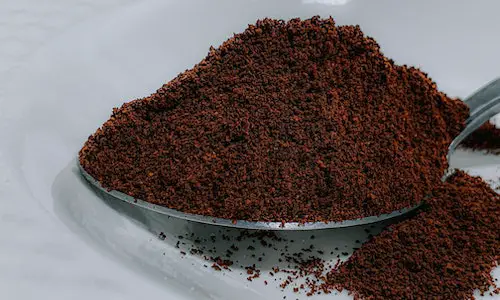If you’re using coffee grounds to add extra nitrogen to your house plants or garden, you may at some point have seen mold growing on it. Because you’ve come to this article, I assume you are also concerned about whether they are still ok to put on your plants.
Fungal growth on coffee grounds is part of the natural decaying process of organic matter and can be highly beneficial to the plants you spread them on due to their ability to assist in the release of nutrients such as nitrogen. Moldy grounds will not damage the plants you add them to.
In this article, we will be taking a deep dive into whether or not you can safely use moldy coffee grounds on your plants. So, for all you need to know on the subject, keep reading!

Related articles
Mold In Your Coffee Maker: How To Clean It And Prevent It
Moldy Coffee And Mycotoxins: Do You Need To Worry?
Mold In Moka Pots: How To Clean In 5 Easy Steps
Mold In French Press: How To Clean And Prevent
Can you use moldy coffee grounds?
You absolutely can use coffee grounds that have a layer of mold on them, as they are still an excellent source of nitrogen , calcium, potassium, iron, phosphorus, magnesium, and chromium. The particular strain of mold you are most likely to find growing on your grounds is called “Trichoderma
, calcium, potassium, iron, phosphorus, magnesium, and chromium. The particular strain of mold you are most likely to find growing on your grounds is called “Trichoderma “, and this will not harm the plants in any way, in fact, this fungi is a completely natural part of the decomposition process.
“, and this will not harm the plants in any way, in fact, this fungi is a completely natural part of the decomposition process.
As long as the mold is dry and “powdery” and it is white, green, or brown in color, you will cause no harm to your plants by spreading the grounds on the soil. The exception to this rule would be if the mold you found growing was in any way slimy, as this could indicate a more advanced state of fungal growth that could contain mycotoxins which can harm plant life.
which can harm plant life.
The obvious exception to this rule would be if you were referring to “using” moldy coffee grounds in the sense of making another brew with them. In this case, the answer would be a resounding no.
Consuming moldy coffee grounds could potentially cause gastrointestinal discomfort , and it certainly would affect the taste considerably, so any mold (or fungi), found growing on your old coffee grounds means it’s time to either throw them away or sprinkle them on your plants.
, and it certainly would affect the taste considerably, so any mold (or fungi), found growing on your old coffee grounds means it’s time to either throw them away or sprinkle them on your plants.
Color variations in coffee ground molds:
There are many different types of strains and variations of molds that you could find growing in your coffee grounds. In the box below, I have listed out some of the most common types, their distinctive features, and whether or not the grounds can still be used.
| Color of fungi | Potential strain | Safe to use on plants? | Reason |
| White | Aspergillus, Penicillium or Trichoderma | Safe to use on and around plants | Trichoderma is naturally found growing in decaying plant matter and none of the strains are known to be plant pathogens |
| Orange | Sitophila, Fusarium, Aspergillus nidulans or Penicillium purpurogenum | Potentially not safe to use on plants. | Fusarium strains are plant pathogens and can cause damage. Without testing it would be difficult to determine the strain. Best not to use on soil |
| Yellow | Aspergillus flavus, Fusarium oxysporum or Penicillium chrysogenum | Not safe to use | Fusarium strains are plant pathogens and will cause damage to any organic matter it is placed on or around |
| Green | Penicillium, Aspergillus or Trichoderma | Safe to use | No known plant pathogens |
| Black | Stachybotrys chartarum | Not safe to use | Creates mycotoxins which are damaging to plants, humans and animals |
| Grey | Botrytis cinerea, Mucor, Aspergillus fumigatus or Fusarium | No safe to use | Fusarium, Mucor and Botrytis are known plant pathogens |
| Brown | Alternaria, Cladosporium, Ulocladium or Aureobasidium | Safe to use | Typically saprophytic and not known to be plant pathogens |
How to use moldy coffee grounds on plants
So you now know that in the majority of cases, you can use moldy coffee grounds on your plants, however, because they are a little moldy, there are a few extra steps that are worth taking to make sure you are keeping yourself safe.
- Assess the amount of growth – If extensive and wet, do not use, if powdery and dry, it is fine.
- Compost further before use – Adding the moldy grounds to a compost bin can help to break down the mold into nutrient-rich fertilizer
- Mix with uncontaminated soil – Mixing the moldy grounds into the soil will help dilute the concentration of fungi.
- Spread evenly – Spreading the grounds thinly over a larger area will prevent moisture retention.
- Use in moderation – Use the grounds sparingly across several plants
Is mold on your coffee grounds dangerous to humans?
Mold growing on coffee grounds may not be hazardous to plant life, however, you should still practice caution when handling moldy grounds, as inhalation or accidental ingestion of the spores can lead to several health complaints in humans, some of them serious.
or accidental ingestion of the spores can lead to several health complaints in humans, some of them serious.
It is always advisable to ensure you are wearing the appropriate safety gear whenever dealing with mold of any kind. Items such as breathing masks, goggles, and eye protection should be worn to avoid coming into contact with the spores.
Some of the more common allergic reactions to spores from fungi include:
- Coughing
- Breathing difficulties
- Runny nose/watery eyes
- Sneezing
- Skin irritation
For people with suppressed immune systems or severe allergies, far more serious symptoms can appear after exposure, so if you are aware that you have any allergies, it is certainly best to avoid contact with moldy coffee grounds completely.
Why do used coffee grounds go moldy?
Once you’ve got everything you can out of your ground-up coffee beans, you may simply put them to one side, ready to either throw out at a later date or to use as fertilizer for your plants.
The reason that mold will begin to grow on these grounds is that you may well have given mold the perfect environment in which to thrive.
Mold needs only a few things in order to grow , moisture, nutrients, an ambient temperature, and a lack of natural sunlight.
, moisture, nutrients, an ambient temperature, and a lack of natural sunlight.
The grounds themselves provide plenty of nutrients, and if not fully dried, the moisture level will be high enough to support the mold as it grows. They are also often left in what’s called the “knockoff box”, (a container for the used-up coffee grounds). If this container is left for even 24-48 hours in an ambient temperature between 60-80 Fahrenheit , mold will certainly begin to grow.
, mold will certainly begin to grow.
How to prevent mold growing on old coffee grounds
If you are concerned about mold growing on the coffee grounds that you plan to use for fertilizer, you can prevent this easily by keeping them as dry as possible.
You can dry them out under direct sunlight, as the sun’s UV rays and heat will kill any mold spores that may land on the grounds whilst dehydrating them to the point where they lack the moisture mold requires.
any mold spores that may land on the grounds whilst dehydrating them to the point where they lack the moisture mold requires.
You can also mix them with dry leaves or grasses to help draw out any excess moisture, as this will have much the same effect.
How do you remove mold from coffee grounds?
In the majority of cases, there is no need to remove any mold found growing on coffee grounds before spreading them onto plants, as is it more likely that what you are seeing is harmless Trichoderma.
Even if mold is seen on the grounds, as long as you are wearing a mask, it would be safe to spread these on outdoor plants (as long as they are green, white, or brown in color). If being used indoors, however, it would not be recommended to use them as fertilizer, as any mold that was present could spread spores throughout the property.
Conclusion
Coffee grounds can get moldy, but in most cases what you are seeing is harmless fungi rather than mold as such. You should still treat this situation with caution, as it is often hard to tell what you are dealing with at first glance.
If you are remotely uncertain of what you are dealing with, it’s important to remember to wear protective equipment when attempting to use or remove it.
Over to you
I hope this article has given you some guidance on whether or not it’s okay to use moldy coffee grounds on your house plants or in your garden as fertilizers. Now I’d like to turn things over to you, have you ever used moldy coffee grounds on your plants, what was the result? Is there anything you think is missing from this article, or do you have any extra tips you think I should add? I’d love to hear about it if you do, so please add a comment and I will get back to you ASAP.

